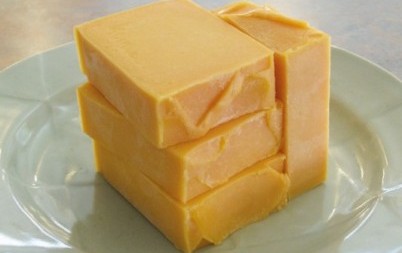Dream of having piles of luxe organic and natural toiletries piled up in your cabinet, but have more a drugstore budget? Learn to DIY. It’s been cool since long before 90’s zines were chock full of knitting and lotion recipes. Sisters on the prairie were churning gorgeous smelling soaps when you were just a twinkle in your Mama’s ovaries.
“The Natural Soap Chef” by Heidi Corley Barto leads you step-by-step through the DIY soap process. You’ll turn wonderful, aromatic ingredients into beautiful soaps—all in your kitchen. Featuring the cold process soap-making method, “The Natural Soap Chef” is packed with easy-to-follow instructions and photos for dozens of inventive recipes: Pink Grapefruit Soap, Chai Tea Soap, Ocean Rain Soap, Pina Colada Soap, Cranberry Pomegranate Soap, Apple Butter Soap, and more delish bars. If you practice now, you may be a pro by holiday and save yourself tons of dough on gifts!
Try on this delicious smelling bar for size;
Pink Grapefruit Soap
This bar has a great scent to wake you up! Paprika gives the soap a pinkish orange color, but it’s up to you whether you want to go through the extra step of making the paprika-infused oil ahead of time. Without the paprika, the bar will be white. Just use regular olive oil if you decide to leave the bar uncolored—it will still smell awesome. You can purchase all organic ingredients online or at your local health food store.
mix temp 115°F
Oils
- 170 grams shea butter
- 170 grams palm oil
- 113 grams coconut oil
- 113 grams paprika infused olive oil (see directions below)
Lye mixture
- 78 grams sodium hydroxide (NaOH)
- 215 grams distilled water
Add at trace
- 34 grams pink grapefruit
- fragrance oil
1. Measure your fragrance into a small glass container and set aside. Measure the oils into a plastic container. Place the container in a larger pot and pour in enough hot tap water that the container begins to float. Set the pot on the stove and turn the heat to warm. Insert a thermometer into the oil.
2. Goggles and gloves on!
3. Measure the distilled water into a heat-safe glass container. Measure the lye crystals into a separate small glass container. Slowly add the lye crystals to the water, stirring with your spatula as you do so. Do not inhale above this container—there will be fumes that can take your breath away. This mixture will heat up quickly. Insert a thermometer into the lye mixture.
4. Monitor the temperatures of the two containers. You want both to reach 115°F. As needed, refresh the hot water bath or turn the stove burner higher to raise the temperature, or use a cold water or ice bath to bring the temperature down.
5. When both the oils and the lye mixture are at 115°F, pour the lye mixture into the plastic container with the oils. Blend with your stick blender until the mixture reaches a light trace stage. Add your fragrance. Blend until the mixture reaches medium trace (see page 26).
6. Pour into your chilled mold. For the top shown in the photograph, tear off small pieces of fresh grapefruit peel, trim away any excess pith (white part), and lightly place shiny side down to cover the loaf top. Lightly cover with plastic and refrigerate overnight.
7. Remove from the refrigerator and let sit at room temperature.
8. Unmold 24 hours after pouring into your mold, cut into bars, spritz with isopropyl alcohol, and place in your curing area.
Paprika-infused olive oil: In a heat-safe glass container, combine 2 teaspoons of paprika with 125 grams of olive oil. Set this container in a larger container, pour in just enough hot tap water that the inner container starts to float, and cover. Leave overnight, then strain through a coffee filter. The oil will be a bright orange, but the end result in your bar of soap will be a pinkish orange.


